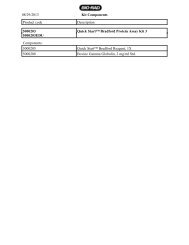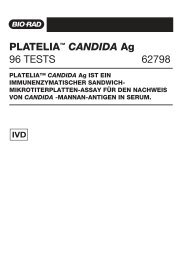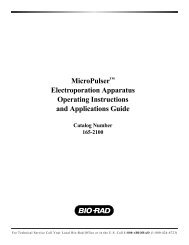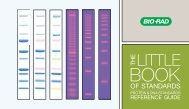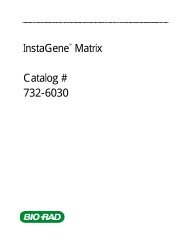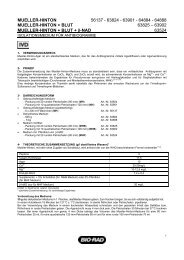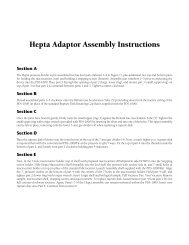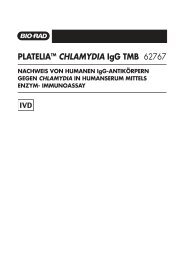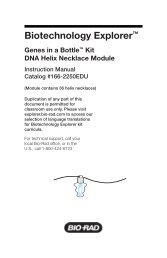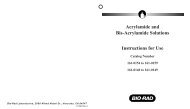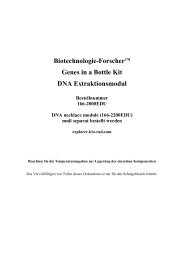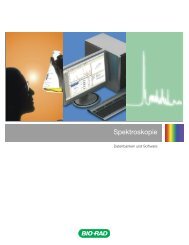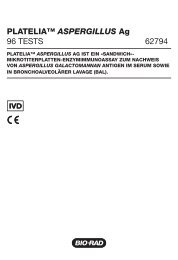Protein Expression and Purification Series - Bio-Rad
Protein Expression and Purification Series - Bio-Rad
Protein Expression and Purification Series - Bio-Rad
Create successful ePaper yourself
Turn your PDF publications into a flip-book with our unique Google optimized e-Paper software.
<strong>Protein</strong> <strong>Expression</strong> <strong>and</strong> <strong>Purification</strong> <strong>Series</strong><br />
Overnight Cell Culture<br />
1. Prepare LB/amp broth: Ensure LB broth is cooled to room temperature before adding ampicillin;<br />
excessive heat will degrade the antibiotic. Add 100 µl of 50 mg/ml ampicillin to each of the four<br />
Erlenmeyer flasks containing 100 ml of LB broth. Swirl to mix. Add 200 µl of 50 mg/ml ampicillin to the<br />
200 ml of LB broth in the 1 L Erlenmeyer flask <strong>and</strong> swirl to mix. The final concentration of ampicillin in<br />
the LB broth in all bottles <strong>and</strong> flasks will be 50 µg/ml.<br />
* LB broth containing antibiotics should be stored at 4°C <strong>and</strong> is good for one month.<br />
2. Dispense LB/amp broth into sterile 50 ml conical tubes: Using the LB/amp broth from the 1 L<br />
Erlenmeyer flask, dispense 15 ml of LB/amp broth into one 50 ml sterile conical tube per workstation.<br />
Dispense 2 ml of LB/amp broth into 2 ml microcentrifuge tubes, one per workstation. Store at 4°C<br />
until ready for use.<br />
3. Aliquot 1 ml of 20% sterile glucose into a 2 ml microcentrifuge tube for each workstation.<br />
4. Set up student workstations according to the student workstation list on page 76.<br />
Subculture <strong>and</strong> Induction<br />
1. Refer to pages 26-30 to help determine the timeline for induction that the class will use. A four hour<br />
induction provides optimal results.<br />
2. Make sure that the incubator shaker or shaking water bath is set to 37°C.<br />
3. Warm up Erlenmeyer flasks containing 100 ml LB/amp broth: At least one hour before the<br />
laboratory period, place the four 500 ml Erlenmeyer flasks in a 37°C incubator shaker, or shaking<br />
water bath <strong>and</strong> warm the medium to 37°C.<br />
4. Set the shaking speed of the shaking water bath or incubator shaker to 250–275 rpm. Once the cells<br />
are added, it is essential that the cells remain suspended <strong>and</strong> oxygenated for proper growth. There<br />
should be some foaming when the cells are shaken.<br />
5. Turn on the spectrophotometer <strong>and</strong> allow it to warm up for at least 30 minutes. If using the<br />
<strong>Bio</strong>-<strong>Rad</strong> SmartSpec Plus spectrophotometer, step-by-step instructions are available in Appendix<br />
D for setting up the instrument for reading absorbance at 600 nm. If using another manufacturer’s<br />
spectrophotometer, please consult the instruction manual for that instrument for setting it up to<br />
measure absorbance at 600 nm.<br />
6. Aliquot 25 ml of 1 M IPTG into a 2 ml microcentrifuge tube for each workstation.<br />
7. Aliquot 1 ml of Laemmli sample buffer into a 2 ml microcentrifuge tube for each workstation.<br />
Note: The set up as described involves distributing 1 ml of Laemmli sample buffer at the subculture<br />
<strong>and</strong> induction stage for each student workstation. This sample buffer will be used throughout the<br />
protocols <strong>and</strong> should be saved by the students. Alternatively, aliquots can be distributed each time the<br />
Laemmli sample buffer will be used.<br />
8. Set up student workstations according to the student workstation list on page 77.<br />
Chapter 3B: Advance Preparation for<br />
Chromatography Instrumentation Protocols<br />
75<br />
CHAPTER 3B<br />
ADVANCE PREP<br />
INSTRUMENTATION PROCES



